|
An Inventory of Marx Playset Figures and Accessories Manufactured from 1951 to 1979
Miniature Playsets
|
Contents of this web site may not be reproduced or duplicated for use on the Internet or for commercial purposes without permission by Eric Johns.
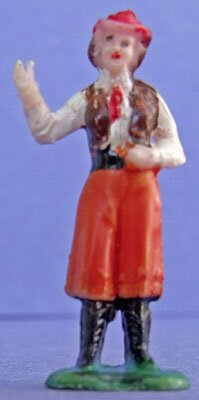 Table of Contents
(click on playset theme to move to the section)
|
| Ancient Times |
| Cartoons |
| Civil War |
| Construction |
| Dollhouse |
| Farm |
| Jungle |
| Medieval Times |
| Military - 19th Century |
| Military - 20th Century |
| Religion |
| Revolutionary War |
| Space Exploration |
| Wild West |
| Back to Special Category Table of Contents |
This web page is intended to provide interested collectors with a listing of and brief information on all Marx miniature playsets. Although contents of the sets are discussed, this page does not have detailed contents lists for the sets. Many of these miniature sets are also shown, or at least mentioned, on other pages of this web site, which display figures and accessories arranged by theme. In some cases, additional information and photos of the miniature sets are on those pages.
 I know of no authenticated list of these miniature playsets. A lengthy article in Plastic Figure and Playset Collector magazine (PFPC) Issue 18 has a list of 45 sets, but also states that it "was compiled from various sources and may or may not be complete." In fact, PFPC Issue 20 lists a 46th miniature World War I set titled Over the Top, and Issue 22 reports an additional jungle-themed set titled Wild Life.
I know of no authenticated list of these miniature playsets. A lengthy article in Plastic Figure and Playset Collector magazine (PFPC) Issue 18 has a list of 45 sets, but also states that it "was compiled from various sources and may or may not be complete." In fact, PFPC Issue 20 lists a 46th miniature World War I set titled Over the Top, and Issue 22 reports an additional jungle-themed set titled Wild Life. Playset Magazine (PM), which began publication in 2002, has not issued an article that features all Marx miniature sets, but has provided information and photos of several sets in many issues. For example, in its second issue, PM provided a 10-page article on the rare Wooden Horse of Troy set, brief information and photos of the Ten Commandments set, and a half-page collage that shows the box tops of most Marx miniature sets. PM Issue 53 has an extensive article on World War II miniature sets that includes content lists for three sets, and Issue 103 has an 8-page article on miniature Wild West sets.
As stated elsewhere on this web site, I am not the originator of most information here. It has been largely drawn from publications such as the former PFPC magazine and the current Playset Magazine, as well as discussions with other collectors. You will notice that many of the photos on this page are of poor quality, sometimes so poor that they provide little except to confirm that such a playset does exist. I thank the several collectors who have provided many photos to me and always welcome photos and information from others to improve this site. I am not the best at e-mail (mine is info@marxwildwest.com), but I will do as well as I can to get back to you.
Marx' miniature playsets have always puzzled me. With hard plastic figures standing an inch or so tall, they have always seemed to me too small for youngsters to play with and far too easy to lose or break. On the other hand, many of the miniatures are attractive sets with painted figures and loads of accessories, which makes them especially attractive to collectors.
| Photo of Assorted Marx Miniature Playset Boxes at left is courtesy of collector Glenn Holcomb |
I must admit that prior to joining the collecting community in 2002, I had neither seen nor heard of a Marx miniature playset. I have since learned that they were popular in the 1960s, prominently displayed in major retailer catalogs, produced and soldby the thousands. I have been told by some collectors that they nearly overtook the standard 54mm playsets in sales. Between college and Vietnam, I guess I was out of the loop by the 1960s! Of course, I now have seen many of the sets displayed in hobby publications and and on Internet sites and have purchased one almost mint set (Western Town) and a few other loose playset figures and accessories.
According to PFPC 18, Marx miniature playsets first hit store shelves in 1963. As pointed out in the article, these sets provided Marx a significant cost savings. Despite being sold for about the same price as larger-scale sets, the amount of plastic needed was far less per set and the smaller boxes cut down packing and shipping costs. Even though pieces were supposedly "hand painted by artists," the sets were produced at Marx facilities in Hong Kong, where labor costs were almost negligible. And, for the most part, figures were downsized copies (pantographs) of figures used in the company's larger scale playsets, which is apparently a cheaper process than creating new sculptures. For example, most of the miniature Wild West cavalrymen are in the same poses as the company's 60mm cavalrymen.
Marx miniature playsets are often stated to be the same scale as HO model trains, but I believe they are actually slightly larger. Collectors sometimes refer to them as 30mm scale, and the figures I have are from 25mm to 30mm tall. That's about an inch, and they are often called just that, one-inch figures. Molded in hard plastic, the items are fragile. Even mint, unopened sets often include broken pieces inside the protective clear plastic bags. Similar to the larger-scale sets, many of the same accessories -- such as trees, rocks, and fencing -- are used in several different sets. However, many of the sets also included unique structures and fun terrain pieces. The sets contain attractive playmats, but unlike the fine-quality, plastic playmats in many 54mm and 60mm sets, the miniature mats are made of paper and roughly printed. However, there are some that are attractive and add much to the set. Based on what I've read, the playmats have their set's name on them, so you can easily tell which playset they belong to. Although most of the playset boxes are illustrated with a photo or drawing, they do not always display the set contents accurately and are made of much more fragile cardboard than boxes used for larger-scale sets.
Though the figures were advertised as "handpainted by artists," rumor has it that the painting was actually done by poorly-paid Hong Kong women and children. In any case, the figure painting for these playset figures was poor, and many figures have big-black-dot eyes. Some of these same tiny figures were sold individually and in small groups, and the painting quality for them seems to be noticeably better. Playsets had numerous accessories that were also painted by these so-called artists. While most contents are hard plastic, a few sets include structures made of cardstock, such as pyramids in the Ten Commandments set and buildings in the Western Town set.
Complete or even partial playsets are especially difficult to locate, and collectors pay several hundred dollars for them. Prices I have paid for individual or small groups of figures have been much more reasonable. Due to the lack of original documentation for these playsets and the fact that contents of the same set have been found to differ slightly from one set to another, the contents of many sets are uncertain, and content lists are often annotated "may or may not be complete."
Ancient Times
Perhaps the longest write-up I have seen on one Marx miniature playset is a 10-page article about The Wooden Horse of Troy playset in PM Issue 2. In it, magazine editor Rusty Kern describes his boyhood thrill at seeing the 1962 movie "The Trojan Horse," his surprise in 1992 at learning of the existence of a Marx Wooden Horse of Troy set from PFPC Issue 18, followed 10 years later by his and Jim McGough's adult thrill of discovering and opening a mint Wooden Horse of Troy set. Quite a story and, as a result, probably making this set about the best documented Marx miniature playset of all. The article includes many photos -- several in color -- and a contents list of the set.
The focal point of the set, of course, is the Trojan Horse, which Rusty describes as "grandly sculpted, with chiseled features, foreboding eyes, stoutly posed legs and tail...and a secret door carved into its left side." The city of Troy itself includes eight 3-inch-high walls, eight towers, and two gates, all unique to this set. Other pieces include 18 Trojans, 17 Greeks, a catapult, a trebuchet (a rolling tower with a catapult-like arm and bucket attached), 12 trees, various small accessories, and a 20-by-15-inch playmat.
The article ends by posing the question as to why this incredible set is so elusive. PFPC 18 in 1992 does mention it, but states that its "contents and origin are unknown" and has no photos of it. Theories abound as to why it is so hard to find, from poor sales because the movie name does not match the set's name to the possibility of a fraudulent set that was not actually made by Marx. Marx miniature playset enthusiast Christopher Wallentine doubts that it was made by Marx. Notably, while the set's instruction sheet states "made by Marx," the Marx name does not appear on the box. Presenting my own thought, maybe this set was just so incredible that youthful owners played it to extinction! We'll never know. But if you come upon a set -- or even pieces of a set -- let Rusty know right away!
Cartoons

Disney on Parade
I'm uncertain why Marx titled this set Disney on Parade, because it is actually a circus set. A short article in PM 77 has several photos of the set and a nice write-up on it. The tent and two sideshow platforms look very much like those in Marx' 60mm circus sets, but are made of cardboard. Like the larger-scale set, this one has three circus rings and various stands for the animals. The photos show the set displayed on what might be the usual paper playmat, but the article does not state that a playmat was included.
The author -- DeAnn Jelinek -- states that she purchased the set mint. However, the article suggests that the set was opened before she won it at an auction, so it is possible that some pieces were added or removed. According to her, the set includes 1) all 34 of the first series Disneykins (see the Disneykins page on this web site), though one dwarf was missing from the box, 2) the six Sleeping Beauty charcters from the second Disneykin series, and 3) the 5-figure group from the 60mm circus sets that depicts the real-life Ringmaster Claude Kirchner, Mary Hartline, and the three clowns Cliffy, Scampy, and Nickie (see the Circus page on this web site). These last five are in their full 60mm size just as they came in the other Marx circus sets, and the animals in the article photos appear to me to also be in 60mm scale. Ms. Jelinek says that the 5-figure group comes unpainted, but the photos show them painted (perhaps she did it herself). Photos show 10 of the 60mm circus animals, also painted.
Ms. Jelinek say that she purchased the set for $142, which seems to me that she got an incredible deal for the set even if she bought it many years ago. The photo of the plain box is one I found on the Internet many years ago, but the article includes a photo of the same box.

Disney See and Play Castle
This is an old photo which I copied off the Internet several years ago, but appears to be the correct box for the miniature Disney See and Play Castle playset. PFPC Issue 18 reports that the castle is the same as the castle in the miniature Knights and Castle set shown below, but has clear, see-through castle walls. From the box photo, it seems to include several Marx Disneykins (see Disneykins page of this web site) and a good number of accessories that I am not familiar with. The PM 18 article includes a photo of the castle with its contents, and the set does appear to have at least two of the houses shown on the box.
Although I live close to Disneyland and once worked there, I am no longer a great fan of Disney, but if those are the correct contents, I'd love to have this very attractive set!
Disney See and Play Doll House
A photo of this Disney house appears in PFPC Issue 10; it is the same as the clear-walled house in the See and Play Dollhouse set shown below. The photo shows that it is populated by several Marx Disneykins (see the Disneykins page of this web site), and accessories include furniture, two cars, a few trees, and a paper playmat. PFPC 18 mentions the set, but adds no information on it.

Flintstones Miniature Set
Again, PFPC Issue 18 includes this set in its list of Marx miniature playsets, but provides no other information on it. Marx collector Christopher Wallentine reports that it was produced solely in Great Britain for a short period of time.
| Photo courtesy of collector Christopher Wallentine |

Munchieville Plantation (vegetable trolls)
The article in PM Issue18 mistakenly lists this set as Munchville. Its "trolls" are walking vegetables. According to the article. it contains the same basic pieces as the Troll Village set shown below, with a few minor differences. It has three buildings, titled Munch Box, Sassies Sauna, and Punchi's Place and a unique playmat.
| Photo courtesy of collector Christopher Wallentine |

Sword in the Stone
Extensive information and photos of this set are in PFPC Issue 21. The set was released in 1963, based on the cartoon movie of the same name. The set includes the 5-tower castle that is also in the Knights and Castle set, but molded in a bright blue color. Three other buildings include a house seven inches long and a Medieval tower structure that is six inches tall. A smaller building is the same as the house in the Troll Village set, with a hat-like roof. Several other terrain pieces used in other minature sets are also included, including four large trees in "autumn" colors and 24 evergreens.
The exact contents of the set are uncertain because the author was not working from a mint set, but character figures and animals from the movie, knights and horses, and numerous small accessories. That would include Wart, Sir Kay, Archimedes, Sir Ector, Pike the fish with an owl on his nose, a green and yellow tiger, and a pink dragon. A large playmat measures 21 by 30 inches.

Tiger Town (tiger trolls)
According to PFPC Issue 18, this set is similar to the Troll Village and Munchieville sets. However, it is populated by troll tigers.
| Photo courtesy of the Arnold Gargiulo Collection |
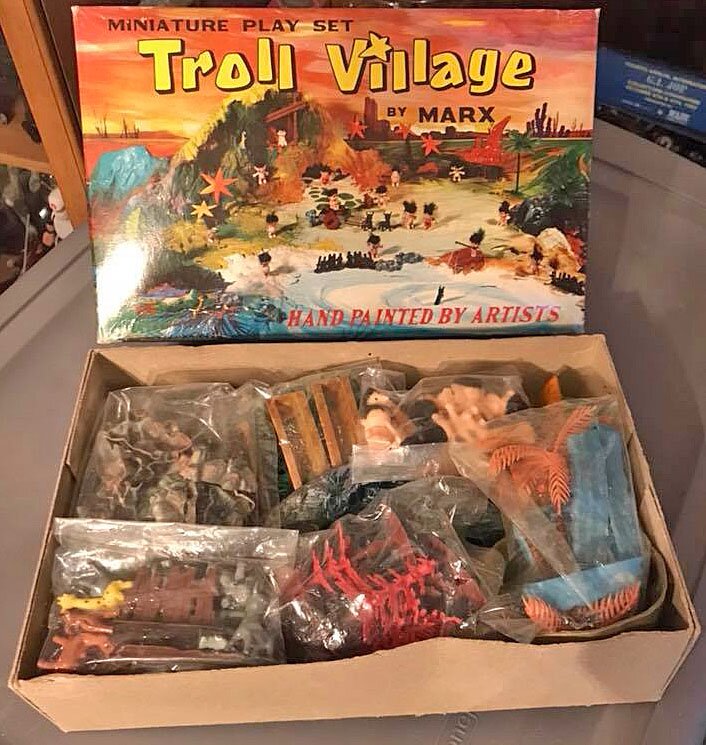
Troll Village
The Troll Village Playset took advantage of a fad in the mid-1960s, small troll dolls with wild orange, red, and green hair, according to a half-page article on the set in Playset Magazine Issue 94. Troll dolls, which were first created in Denmark in 1959, became one of the U.S.'s biggest toy fads in the 1960s with their big eyes and wild hair; their popularity in the U.S. has resurfaced several times since then.
Besides a dozen unclad trolls, the sets included animals and various terrain pieces. According to the PM article, it also includes an odd house with a strange hat-like roof, two nice mountain pieces with caves, and the usual paper playmat. The article includes a photo of the set and a content listing.
PFPC Issue 18 also includes information on the set, but suggests it includes one mountain piece and two houses. However, the included photo suggests that the second "house" could be considered a mountain piece with a cave, which is also shown in the PM article.
Collector Christopher Wallentine says that this set was issued in three different sets, but in unsure whether the contents were the same in each box.
Civil War
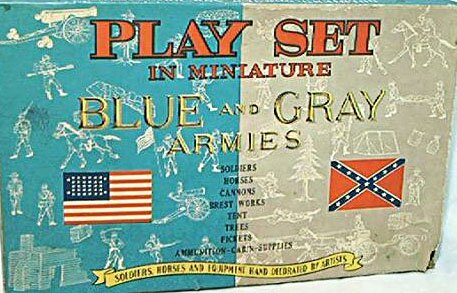
Blue and Gray Armies
According to PM Issue 71, this was one of the first three Marx miniature playsets to appear in the Sears catalog. Based on a photo of the ad in the magazine, the set contains 101 pieces and costs $4.44.
PFPC Issue 18 reiterates the 101 pieces and states that the set includes 26 Union soldiers and 28 Rebels, as shown in the 1963 Sears ad. That article also agrees with contents stated in the ad. These include horses, spiked barriers, and cassion and cannons, and other small accessories, which PFPC points out are generally down-sized versions from the 54mm sets, except for six different stretcher group poses. However, there are also accessories of unknown origin such as a destroyed cabin, two bunkers, and a gatling gun.
PM 71 Issue 71 has a 2-page article on this set that notes the author found 26 Union and 29 Rebel soldiers in both sets he reviewed for the article. One of the two sets was unopened and mint, and items in the two sets agreed. As a result, the article included a list of "Intended Set Contents," which generally agrees with the contents noted in the PFPC article and information in earlier PM Issue 40. However, the PM 71 list specifies two horses (confirming the presence of one mounted figure on each side), gives specific count pieces for all items, and includes a 15-by-20-inch paper playmat. It also says that one cannon is black and one gold.
The earlier PM 40 has a partial contents list for this set based on the contents of an unopened, mint box. That list has 25 Union (one mounted), 23 Rebels (one mounted), plus two 3-figure stretcher sets, one for each side. Specified accessories seem about the same as reported in PFPC with six spiked barricades, one cassion and cannon plus a separate black-barrel cannon, a destroyed cabin, a pup tent, two bunkers, and a gatling gun. Crates, barrels, and cannon balls are also cited, but no numbers shown.
PM 38 also has small photos of a few figures and the box cover.
Construction

Riverside Construction
PFPC Issue 18 notes that this set is based on the larger Construction Camp playset made by Marx. I have found no other information on it, but Marx miniature playset enthusiast Christopher Wallentine reports that it was a Montgomery Wards exclusive item.
| Photo courtesy of collector Christopher Wallentine |
Dollhouse

See and Play Doll House
This "playset" is a little different. There is a humorous article about it in PM 7, written by Mike Holverson. Featuring a typical dollhouse, but with see-through walls, it includes several women striking poses in bathing suits and similarly alluring attire (down-sized from those on the Promotional Items, Celebrities, and Sexy Women page of this web site), a seated gentleman caller, and a cook holding a pie, who looks suspiciously like the pieman that Simple Simon met in the company's fairy tale figures. Otherwise, according to the PM article, the set has some furniture and a couple of cars. The PM article has several photos of the set. I would suspect that this "playset" did not go over particularly well with the boys and girls of the 1960s, but it might be a big hit among us collectors today!
| Photo courtesy of collector Christopher Wallentine |
Farm
 Sunshine Farm
Sunshine FarmThe only written information I have on this set is that it is shown as one of 45 sets listed in PFPC Issue 18. Based on photos from collector Christopher Wallentine, the set includes miniaturized versions of what is in Marx' larger-scale farm sets: farmers including tractor drivers, farm animals, sheds and a silo, fencing, trees, and various farm equipment. I do not see a barn in Wallentine's photos of contents, but feel sure that the set included a hard plastic barn. And maybe a farm house? It did include the usual paper playmat, featuring fields of crops and a pond.
PM editor and publisher Rusty Kern reports that this set is a "mess" and one of the worst playsets Marx produced. He points out that the scale of items in the set is inconsistent and that the fence is particularly "goofy."
| Photo courtesy of collector Christopher Wallentine |
Jungle

Jungle (2 versions)
This set came in small and large sizes. The article in PFPC Issue 18 states that the larger set had "more than 260 pieces with over 100 trees, palms, ferns, and bushes." Sounds like a good jungle to me! It also had at least 80 animals, many down-sized from the company's larger-scale sets and also used in the miniature Noah's Ark set. Many of the natives and hunters also were drawn from those previous sets. The set has a unique lookout tower -- missing from the larger-scale sets -- a down-sized version of the cave included in the Zorro playset, dugout canoes, a jeep, and many other small accessories. The set included the usual paper playmat.
| First photo courtesy of Ebay ID goodtoystore |
Jungle Safari
PFPC 18 lists this as a Marx miniature playset, but I have found no other information on it. Marx miniature playset enthusiast Christopher Wallentine doubts that it actually exists.

Wild Life
PFPC Issue 21 includes an article with significant information on this set, including a contents list complied from a previously unopened set about 1992. The parts count in this set is rather low, with six African natives, six hunters, two huts, and various small accessories (supply sacks, crates, campfire, log pile, etc.). However, the contents list also shows 26 animals and 14 trees in three styles that make a downright beautiful display on the usual paper playmat, based on a photo in the article. As Marx sometimes did, the animals include a few incongruos spieces, such as a buffalo and a polar bear!
The article suggests that this set might be derived from the 1962 movie "Hatari," which starred John Wayne. It points out numerous similarities in the playset with the movie's characters, animals, and even the set's playmat!
 PM Issue 77 includes an article with a photo of the playmat shown at left with some of the set contents on it, as well as brief information. The set had 11 figures. but one of the two females was "a terrific female hunter who appears to have fallen in the classic femme-fatale mode." The article does not state which Marx jungle set the items come from, but if it's from this Wild Life set, tht statement seems to support the movie tie-in.
PM Issue 77 includes an article with a photo of the playmat shown at left with some of the set contents on it, as well as brief information. The set had 11 figures. but one of the two females was "a terrific female hunter who appears to have fallen in the classic femme-fatale mode." The article does not state which Marx jungle set the items come from, but if it's from this Wild Life set, tht statement seems to support the movie tie-in.| Photos courtesy of collector Christopher Wallentine |
Medieval Times
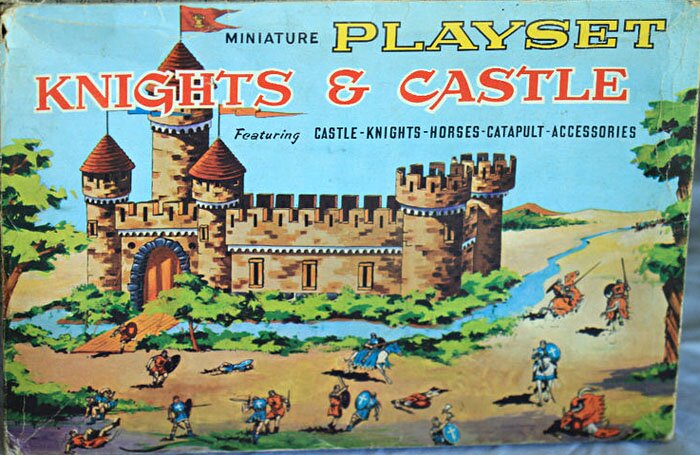
Knights and Castle
According to PM 18 the Knights and Castle set includes 132 pieces and a castle that measures 11 inches wide, 7 inches deep, and 7 inches tall. With 16 gold and 16 silver knights, it provides an opportunity for an even fight between two Medieval armies. It also includes horses, a catapult, various trees, and the usual paper playmat.

Knights and Vikings (2 versions)
PFPC Issue 18 states that both the small and large versions of the Knights and Vikings set included a 5-sided castle, with the fifth side being the gate set at an angle to the two walls it connects. The smaller version of 64 pieces with 16 knights, 16 Vikings, four horses, catapults, an "invading tower" (a trebuchet, as found in the Wooden Horse of Troy set), and various other accessories. A larger version of 143 pieces has "about double the contents" plus a battering ram and a large mountain or rock formation that also is in the Charge of the Light Brigade and Charge of the Bengal Lancers described below.
 An article in PM Issue 13 confirms the existence of two versions and the same piece counts in PFPC for these 1964 sets. However, it
An article in PM Issue 13 confirms the existence of two versions and the same piece counts in PFPC for these 1964 sets. However, italso notes that one set they used for the article had 32 knights and 32 Vikings, perhaps a medium-size set. The description of accessories is about the same as the PFPC version, and it points out that the trebuches are the same as those in the Wooden Horse of Troy described above, but catapults are different. The article also notes that the 5-sided castle is black with swirls of blue and gray, appearing much more dark and brooding than the "cheery" tan castle in the Knights and Castle set.
| Photo of second Knights and Vikings set courtesy of collector Christopher Wallentine |
Military -19th Century

Charge of the Bengal Lancers
If you are unfamiliar with Bengal Lancers, don't worry, so am I. A quick look on the Internet shows that Bengal cavalry units were formed in India by the British in the 1800s and remain a part of the Indian Army today. Initially lancers on horseback, they were involved in several wars in the 1800s, as well as both World Wars. Though still using horses in World War I, they were deployed as mechanized reconnaissance regiments in World War II, and became tank units after that war. I am not sure if this set is based on a specific battle or simply another use for molds made for the Charge of the Light Brigade sets described below. I welcome more information on these Bengals!
In this set, British officers are dressed in tan uniforms with spiked helmets, while enlisted men (brown-skinned figures) wear turbans, according to PFPC Issue 18. Their opponents are the same Arab figures that are in the Light Brigade sets.
Accessories are about the same as the Light Brigade sets, including the large rock formation.
A PM feature article in Issue 27 on the Charge of the Light Brigade also includes brief information of Charge of the Bengal Lancers. It reports that parts are about the same as those in the Light Brigade set described below, except that the red British lancers are replaced with British troops dressed in khaki uniforms from the Bengal region of India. The used set seen by the article author included 47 British and 43 Indians Rebels. There are two of the large rock/mountain formations from the Light Brigade set and also two smaller rock formations about 4-1/2 by 3 inches.

Charge of the Light Brigade (5 versions)
The real Charge of the Light Brigade -- made famous by Alfred Tennyson's poem by that name -- was a military action in the Battle of Balaclava in Turkey during the Crimean War. It took place in October 1854, pitting British light cavalry against Russian forces. I am not conversant on military battles, but -- according to PFPC 18 -- for some reason Marx recreations of the action seem to take some liberties with the participants, including Arabs and Indians (no, not American Indians). I welcome more information on this battle!
| First photo courtesy of Ebay ID goodtoystore |
The list of Marx miniature playsets in PFPC 18 shows five different versions of the Charge of the Light Brigade set, but discusses only three sets in the related article. The list shows a large and small set that includes Cossacks and lancers, a large and small set that includes Arabs and lancers, and a single set that has Arabs and legionaires. I am assuming that the lancers and legionaires both refer to the British
 troops.
troops.According to the article, one set, sold by Sears in 1964, had 216 pieces with 48 British soldiers in red and white uniforms and gold helmets versus 50 Indian figures. A second set includes 56 British lancers against 75 Indians/Arabs. And a third set has the red-coated British soldiers versus blue uniformed Hussar Russians. The article shows no numbers for the third set. It does not explain how these three sets relate to the subsequent list of five.
| Second photo courtesy of collector Christopher Wallentine |
All versions had numerous horses, cannons, cassions, cannon balls, trees, spiked barricades, British and Indian (?) flags, and a large rock formation. The rock formation was also used in the larger Knights and Vikings set shown above.
The set is featured in PM Issue 27, with a beautiful full-color center spread of the entire set. The article agrees that there were several versions of this set in 1964 and 1965. Initial photographs in the article show of a set show opposing forces of red-and-white uniformed British soldiers against turbaned Indian rebels. There is a contents listing for a 1964 set at the end of the article, which appears to detail this set.
However, the article later cites to other versions, a Sears and a Russian. The Sears version is said to contain Cossacks (this would be Russian soldiers?) dressed in red rather than British soldiers going up against "uncommon" white Arabs instead of "Indian rebels or Russians." The Russian version came in two versions, a smaller one with 30 British and 26 Russian figures and a larger one with 50 mounted British, eight British on foot, seven mounted Russians, and 20 Russians on foot. However, these counts came from opened, used sets.
The PM contents list cites 64 British figures in red and white (37 mounted) and 75 multi-colored Indian rebels (28 mounted). Other pieces include the usual playmat (21 by 29 inches), a large mountain piece (11 inches long and 2-1/2 inches tall), 65 (!) horses, cannons, trees, cloth flags, and a few other small accessories.
Military - 20th Century

Barrack Set
This set was not included in the article on Marx miniature playsets in PFPC Issue 18. I have found no information on it, other than this photo of the box from Marx miniature playset aficionado Christopher Wallentine. He states that it was released solely in Canada, which may be why it has the French writing on the box top.
| Photo courtesy of collector Christopher Wallentine |
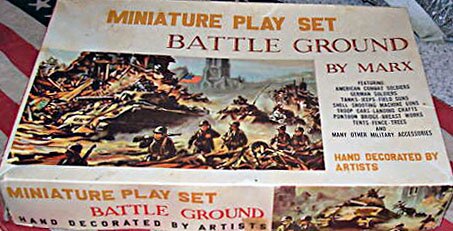
Battleground (World War II)
The PFPC Issue 18 article states that this set contains 38 GIs, 8 Germans, and an assortment of vehicles and accessories down-sized from the company's larger-scale playsets. The set had 170 pieces and included the usual paper playmat. The article notes that it has cloth flags for both the U.S. and Germany, and suggests this may have been the first toy to include the Nazi swastika flag.
PM Issue 53 reports the same figure count and includes a list of set contents. The list itemizes many down-scaled accessories -- jeeps, tanks, cannons, tents, pontoon bridge, barbed wire fence, damaged house, etc. -- and a paper playmat with a river running through it. It points out that, overall, contents are minimal compared to other Marx miniature military sets, such as Invasion Day and 20 Minutes to Berlin. However, those larger sets do not includes the tiny machine guns and mortars found in Battleground.
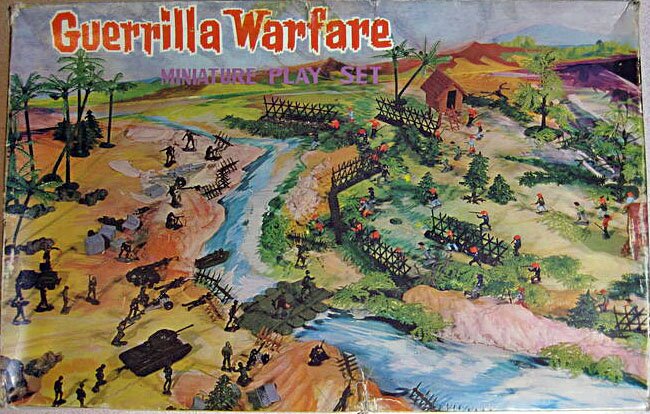
Guerilla Warfare (Vietnam War)
In this set, 40 U.S. combat troops face off against 40 Viet Cong (in 8 poses), according to PM Issue 18. Accessories are jeeps, howitzer, rafts, pntoon bridge, trees, palm, rocks, spiked barricades, some unique bamboo pickets, etc. Two jungle huts are also included, down-sized from the Marx jungle sets. Based on the box cover, the usual paper playmat is also present.
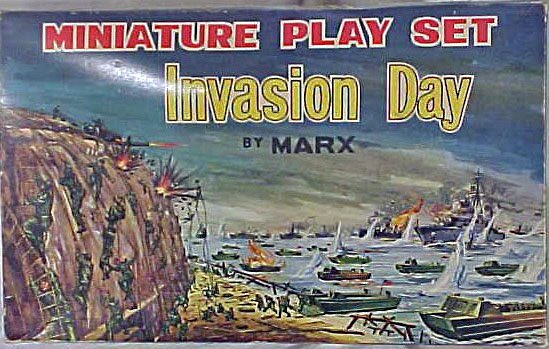
Invasion Day (World War II)
In 1964, Marx released this whopping 304-piece set that included large mountains and 30 each of U.S., German, and British soldiers, according to PFPC Issue 18. The article notes that it included "about 18 out-of-scale naval ships," ranging from tug boats to destroyers. Also is the same mountain piece in the Iwo Jima set (without the GIs raising the flag) as we well as "an added piece to make it twice as long." It has a similar array of vehicles and accessories as are found in the Battleground set, as well as the Nazi flag mentioned below in the 1963 20 Minutes to Berlin set.
An article in PM Issue 53 18 years later disagrees with the PFPC figure count and includes a contents list for this playset, derived from a mint-in-box set. It includes an astounding 53 GIs, 25 Germans, and -- not found in the other military sets -- 40 British soldiers. It lists the 18 smallish ships and boats that PFPC mentions, the largest being guided missile cruiers at 6-1/2 inches and the smallest being 1-1/2-inch PT-type boats (no tug boats). Destroyers and frigates are also included. Based on the PM list, scaled-down accessories are plentiful, plus two 11-inch moutain pieces with 5-inch extensions and even two L-shaped corral atoll pieces from the Iwo Jima set.
The playmat depicts colorful beachfront property with ocean area for the ships.

Over the Top - World War I
According to PFPC Issue 20, the Over the Top Play Set is rare, only one set known to be in existence when the magazine was published in 1992. Based on that one set, its contents are very close to the Trench Warfare set. The article notes that the primary differences are items which are in the Over the Top set, but not in Trench Warfare. These include 1) a 1917 vintage automobible, 2) a French WW I bi-plane, 3) a German WW I tri-plane, a 1950s style ambulance that also came in the Invasion Day set, and an over-scaled WW I firing cannon.
The article includes photos of these items, as well as the box and the playmat.
| Photo courtesy of collector Christopher Wallentine |

Sands of Iwo Jima (3 versions)
According to the PFPC Issue 18 article, this set was issued in three sizes: 88 pieces, 205 pieces, and 296 pieces. Each has similar pieces, and they differ only in numbers.
However, the article details contents of the 205-piece set, noting that it includes an "island hilltop mountain" and a smaller ground piece with four GIs posed to simulate the famous flag raising at Iwo Jima. The article has a photo showing this ground piece and the flag raising placed on a level area on top of the mountain. It is unclear whether these are in the other two Iwo Jima sets. Otherwise, this set hs 44 GIs, 48 Japanese soldiers, tanks, jeeps, field artillery, trees, cloth flags, and numerous other small accessories.
Trench Warfare - World War I
PFPC Issue 18 mentions this set and includes a content listing for it, as well as a photo of the contents. The article states that the content list is believed to be complete, but strangely does not include any U.S. soldiers. Instead, there are 16 German soldiers and 15 French soldiers. Also shown are several small buildings and walls, two tanks, and a cassion with cannon and horses, trees. a French flag, but no playmat. And no trenches.
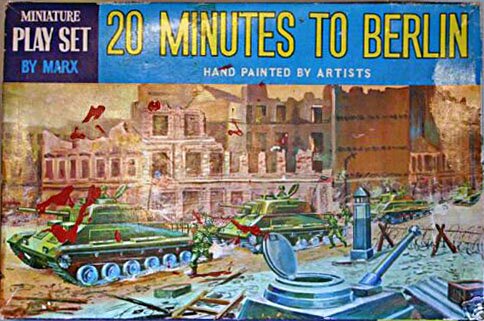
20 Minutes to Berlin (World War II)
PFPC Issue 18 states that this was the most popular of the miniature war sets, including 40 American GIs and 40 German troops, as well as several unique pieces. However, it also notes that the set is historically inaccurate, because it was Russian troops that captured the city at the end of WW II. One reason for its popularity is because it includes a whopping seven ruined buildings, as well as seven U.S. tanks, two German armored cars, a unique German Panzer tank, an ambulance, numerous small accessories (dead trees, telephone poles, fuel drums, cloth flags, etc.), and the usual paper playmat. The author counted more than 200 pieces in the set.
A PM Issue 53 article on the WW II sets has a contents list of this set made up from a mint-in-box set, which seems to generally agree with the PFPC description.
Religion
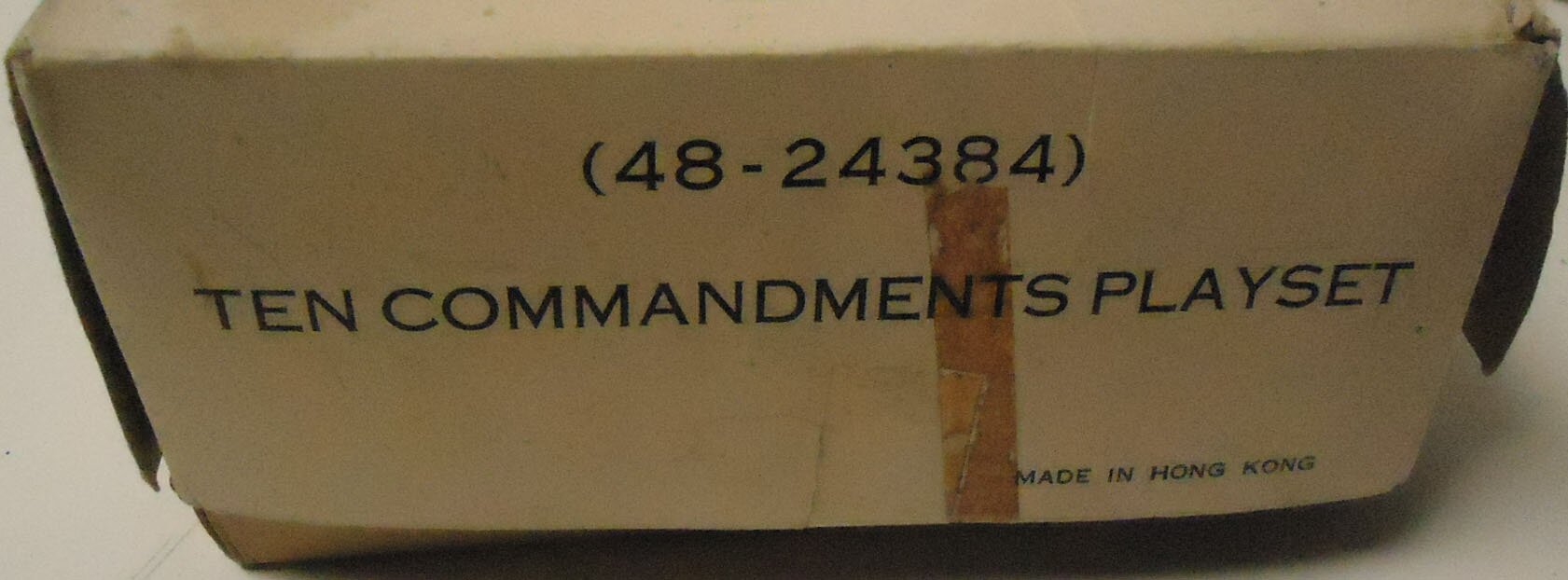 The Ten Commandments
The Ten CommandmentsPFPC Issue 18 includes a content list of this set and good photos of the contents. The article also states that this is probably the only miniature playset that traces its "character relationship" to a movie, though the epic movie of the same name was released in 1956, several years before the playset was produced. I'm not sure what that means, though the set and movie have the identical name and both include the character Moses, of course.
PM Issue 2 has a half-page article on the set, which includes a photo of its playmat that is divided in half by the Red Sea, adding tremendously to the set's appearance. A PM photo also shows the set's box, which is made of thin, undecorated cardboard with no decoration. The set name and a number (48-24384) are stamped on the end of the box, as shown at left. The set was sold exclusively by Montomery Wards.
The set included several unique accessories, such as a golden calf idol, two cardboard pyramids, a burning bush, a 12-inch long mountain, and no less than three character poses of Moses. Also present are eight Egyptians (with a pair of chariots), 32 Israelites, a foot-long mountain, smaller rock formation, palm trees, two small cardboard pyramids, camels, cows, and sheep.
Three small photos of the set are also included in PM Issue 104.
| Photo of Ten Commandments box courtesy of collector Mick Weitzel. |
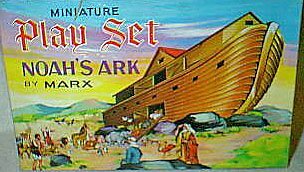
Noah's Ark (2 versions)
PFPC Issue 18 reports that this set came in a small and large version. The smaller set included 100 pieces, including about 40 pairs of animals, six members of Noah's family, and an ark with a loading ramp. Oddly, the ark was topped with a house from Marx HO train sets. The article says that that the set also included palm trees and rock formations, but includes no other information. Many of the animals were the same ones included in the miniature jungle sets.
Revolutionary War

Revolutionary War
This seems to be a rather small set, as PM Issue 18 states that it has only 21 Colonist and 16 Red Coat figures, all down-sized versions of the 60mm Warriors of the World figures. Accessories are similar to those in the Blue and Gray set described above, but include a second cabin, two additional cannons, and -- of course -- not the gatling gun.
A brief half-page article in PM Issue 39 claims there are 21 figures on both sides, but also states that there are more fence pieces in the set than figures! The set has a 4-horse cassion for the set's cannon, but otherwise has only one horse, that being for Paul Revere, of course.
| Photo courtesy of collector Christopher Wallentine |
Space Exploration
Space Set (actual title unknown)
I can find no information on this set, other than PFPC Issue 18 notes that it exists. PM Issue 17 has an article on a miniature Apollo Exploration playset that it states may be made by Marx, but I find it hard to believe based on photos of the contents. Having searched for such a set for several years, Marx miniature playset expert Christopher Wallentine believes that Marx made no miniature set related to outer space.
Wild West

Attack on Fort Apache
This set was briefly cited in PFPC Issue 18 in 1992 as having been recently discovered in England and containing "covered wagons, cowboys, a unique livery stable building, and 7 different mounted Indians poses of unknown origin. I find no other reference to it until PM 103 of 2019 noted it as a "previously unreported Fort Apache: HK-8078, Attack on Fort Apache from 1966." According to the PM article, it combines the larger Fort Apache set and the Covered Wagon Attack set for a huge set of 225 pieces. It includes the fort with a headquarters building, 16 cavalrymen, 25 pioneers/cowboys with the stretcher team from the Covered Wagons set, 29 Indians on foot, and 15 mounted Indians. As with the Covered Wagon set, there are four covered wagons, a buckboard, various fort accessories, farm animals, and the usual paper playset mat.
PM also states that the set includes the unusual 5-inch-long hill formation with a low round mesa on its top, which was also in the Covered Wagon set.
As shown in the photo, the box is undecorated with only the set name and number on it.
| Photo courtesy of collector Christopher Wallentine |
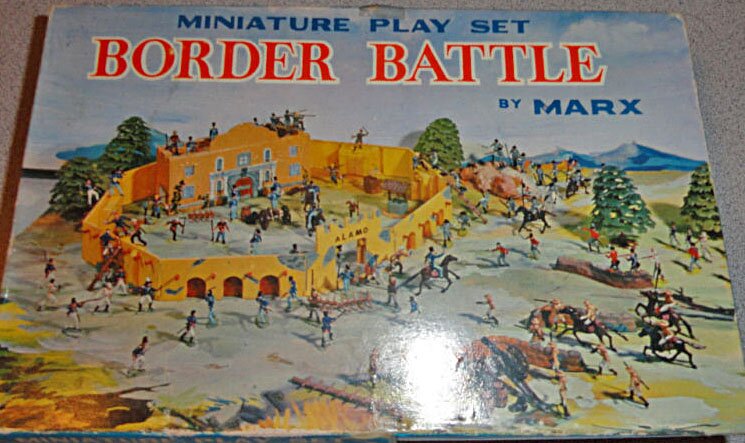
Border Battle (The Alamo)
This set is featured in PM Issue 85. The article reports that the set was not sold by any major retailer -- such as Sears or Wards -- and that its exact contents were uncertain until a "pristine" set was discovered shortly before the article was published in 2016. As a result, a content listing for the set is included with the article.
Based on the articles in PM Issue 85 and PFPC 18, the set uses down-scaled Mexican soldiers from Marx' original Alamo and Zorro playsets, as well as from its group of Warriors of the World. This allows the set to more realistically display an accurate depiction of the battle with only nine Alamo defenders fighting against 40 Mexicans. Accessories include the Alamo chapel, gate, and six walls in hard tan plastic, horses, ladders to scale the fort walls, flags, cannons, assorted Wild West outdoor accessories (log pile, well, hitching post, etc.), and various terrain pieces, as well as the usual paper playmat.
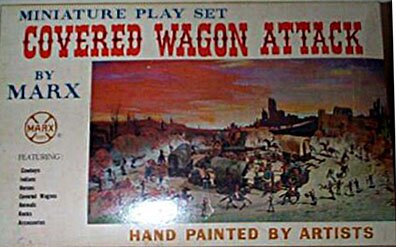
Covered Wagon Attack
PM 103 points out that this is the only miniature Wild West set that does not include cavalry. Instead, it is populated by 20 pioneers and 36 Indians, 16 of them mounted. In the photos, however, what the article calls pioneers appear to be dressed as civilians or Marx cowboys, not pioneers. These include the woman carrying a basket from the 60mm Roy Rogers town cowboys (!) and two women carrying a patient on a stretcher. There are four covered wagons (five per PFPC 18) for the pioneers to use as protection from the attack. Small accessories include the usual boxes, rocks, cacti, paper playmat, etc. This is the most difficult miniature Wild West set to find.
PM also states that the set includes an unusual 5-inch-long hill formation with a low round mesa on its top, which was also in the Attack on Fort Apache set. The article suggests the hill may be unique to these sets, however based on photos in PFPC 21 of the Sword in the Stone set, I think it was also used there.
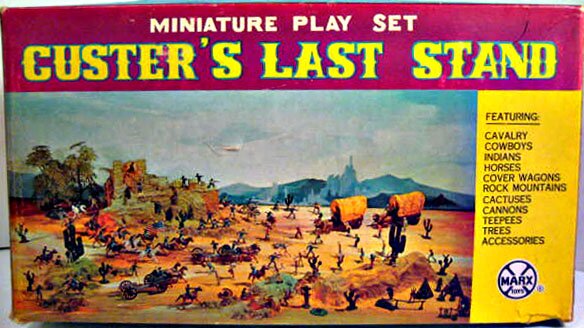
Custer's Last Stand
PM 103 states that this set includes 41 cavalry figures, 14 pioneers, and 37 Indians on foot. No mounted Indians. It has a unique 10-inch long and 5-1/2-inch wide "butte rock formation that barely fits in the box" (see at left) and a long bluish mountain piece that is found in a few other sets. Other accesories include two cassions with cannons, numerous small rock piles, two Conestoga wagons, and the usual paper playmat.
PM 3 also has brief information on the set and a couple of small photos.
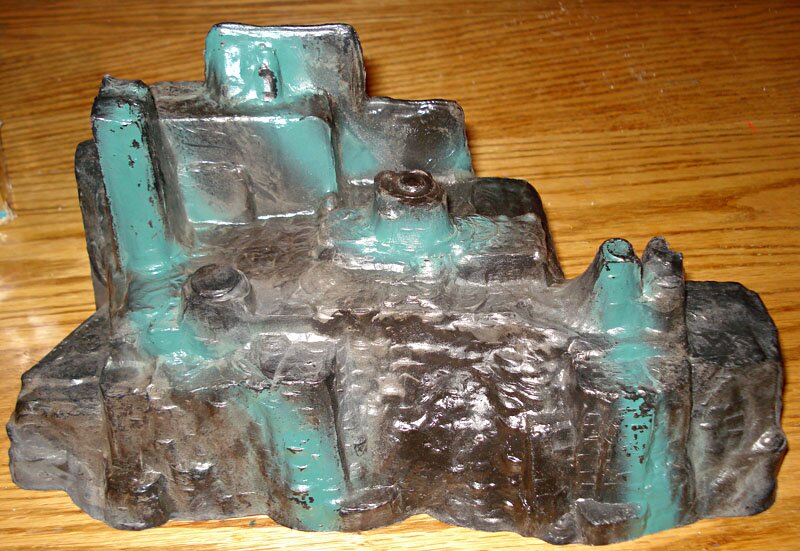
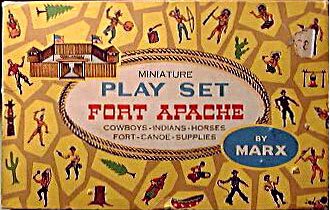
Fort Apache (2 or 3 versions)
There seems to be some uncertainty as to the number and exact contents of the miniature Fort Apache sets. PFPC 18 reports that there were three sets issued. First, a set with 16 cavalrymen and 16 Indians, along with the down-sized fort that is identical to its larger version. Various accessories included a cassion with cannon and horses, trees, flags, and both small fort and Indian accessories (such as a tepee and canoe). A second version replaced the cavalrymen with cowboys and cowgirls with all other pieces the same. And a third version has the same contents as the first version with added cowboys, a "livery stable building," and farm animals. This final version was contained in a larger box with a diorama of the set on its cover which I would assume is the third photo to the left.
PM 103 agrees that the "first" Fort Apache miniature set included 16 cavalrymen (four mounted) and 16 Indians (none mounted) and a fort identical to its larger version with nine wall pieces and two block houses. However, it notes that the first two sets cited by PFPC were a large and small version, both released in 1963. The article states that the small set had 68 pieces and the
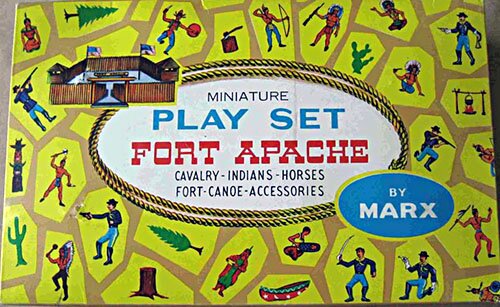 large one 98, though no contents list is included.
large one 98, though no contents list is included.PM states that for the larger set, a few Indian accessories (tepee, totem pole, etc.) were added, as well as five cowboys/cowgirls, five small rock pieces, and a group of 21 farm animals. It agrees with PFPC that there were 16 Indians, but does not mention cavalrymen. However, based on the piece count, I would have to assume that those were present also.
PM also agrees that a building was added to the larger set, but a supply headquarters with a cupola for the fort. Based on photos in the magazines, this appears to be the same building dubbed a livery stable by PFPC, a down-sized version of the tin litho cavalry buildings shown on the Wild West Accessories page of this web site.
The PM article also reports that it was this larger (or second) version that came in the third box to the left with a diorama on it.
And strangely, information from both PFPC and PM disagree with the top two boxes I show at the left, which state that cowboys were in
 one set, Cavalry in a similar set, and based on the cover photo, Cavalry were in a third. Unfortunately, these are photos I copied from the Internet -- perhaps Ebay -- many years ago, so have no idea of their source.
one set, Cavalry in a similar set, and based on the cover photo, Cavalry were in a third. Unfortunately, these are photos I copied from the Internet -- perhaps Ebay -- many years ago, so have no idea of their source.See also the rarer Attack on Fort Apache set above.
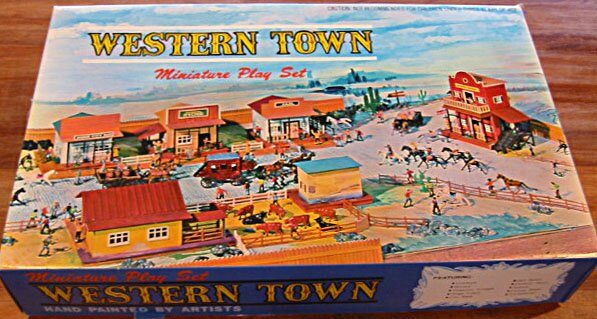
Western Town
Also mentioned in PFPC 18, this set is unique in that it includes six attractive cardboard buildings with hard plastic roofs and porches. It has 65 figures down-scaled mostly from the 54mm cowboys and miners group and the 60mm town cowboys. They include poses of Dale Evans and Wagon Train's Seth Adams and Flint McCullough. Accessories include horses, farm animals, fencing, wagons, and a stagecoach.
